The Mildenhall treasure
The Mildenhall treasure was found in 1942 by a farmer while ploughing in the village of West Row near Mildenhall in county Suffolk. The hoard came into the possession of the Ford family and four years later, in 1946, it was acquired by the British Museum. It was considered the largest Roman precious metal hoard in Great Britain for half a century after its discovery, until the Hoxne treasure was found in 1992.
The hoard is a silver dining set comprising 34 pieces with a total weight of approximately 26 kilograms and some 1.735 kilograms in gold value. Its central piece is a large (more than 60 cm in diameter and more than 8 kg in weight), flat platter, probably also used for serving food. Its entire surface is ornamented with reliefs: Dionysus and his entourage are depicted on the rim, an inner frieze presents sea creatures and Nereids, while Oceanus appears in the centre. The representation of Dionysus’s entourage shows a high degree of similarity with the depictions on the Dionysus ewer of the Seuso treasure. The set includes two smaller flat platters, which are also decorated with the figures of Dionysus’s entourage. Judging by the style of depiction, they must have been made in the same workshop where the large platter was crafted. Further pieces are: a large serving platter with geometric design inlaid with niello (approximately 5 kg), four widely flanged bowls with figurative decoration in reliefs and two smaller bowls (for sauces, soup or stews) decorated with embossed undulating lines, a covered bowl decorated with hunting scenes, two small stemmed dishes (for serving perhaps dried fruit or seeds), a fluted deep bowl used for washing hands, five small ladles with handles in the shape of dolphins (for liquids), as well as eight spoons (presumably for desserts). Judging by the style of their decoration, the dishes must have been made in different workshops, presumably in significant centres of the Roman Empire. The dining set was probably a gift from a high-ranking official or perhaps from the emperor himself presented to another high-ranking official.
From the middle of the 4th century the province of Britannia was often attacked by neighbouring peoples and it was no longer part of the Roman Empire by around 410. The treasure must have been hidden by its owner presumably carefully packing it in a box during a chaotic period sometime between 380 and 420-430.
Read more about the treasure:
The Mildenhall Treasure Project (British Museum)
The Mildenhall Treasure: a secret history
The Mildenhall Treasure (animation)
Explore the Mildenhall treasure on the Google Cultural Institute
Bibliography:
Painter, K.S.: The Mildenhall Treasure: Roman silver from East Anglia, London 1977
Hobbs, R.: The Mildenhall Treasure, London 2012
Richard Hobbs: The Mildenhall Treasure: Late Roman Silver Plate from East Anglia, London 2016




